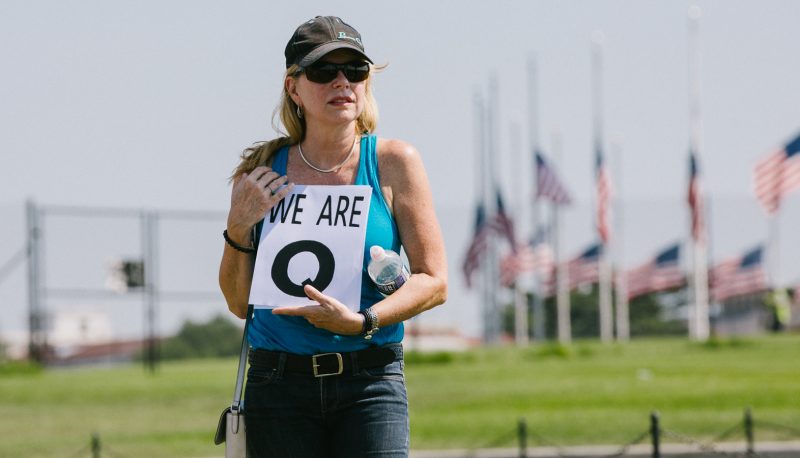At an August appearance in the White House briefing room, President Donald Trump told reporters that he didn’t “know much” about the QAnon conspiracy theory and its followers “other than I understand they like me very much, which I appreciate.” Two months later, Trump would again decline an opportunity to disavow the QAnon movement when asked by reporter Savannah Guthrie at an NBC News town hall program.
It’s not surprising that Trump would appreciate QAnon believers: In every iteration of QAnon lore, Donald Trump is at the center, cast as a noble, crusading and kingly character. He’s said to be battling a global, Satanic cult that traffics children for sex—a cult ostensibly made up of Democratic leaders, business executives, and Hollywood figures. Trump is said to be working in secret to foil all the evil purportedly perpetrated by people who, coincidentally, also happen to be critics or opponents of the president. The promise of the QAnon story is one of bloody vengeance: Once the evil plot is defeated by Trump, the story goes, there will be mass arrests and executions of all who are said to be agents of Satan. This anticipated event is known to QAnon people as “The Storm.”
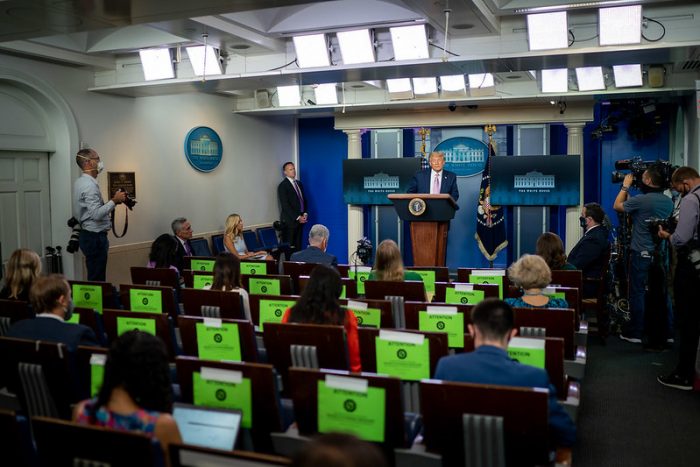
As outlandish as the claims propagated by QAnon followers are, the movement has become an undeniable threat heading into the 2020 election and beyond. The Federal Bureau of Investigation considers QAnon a potential source of domestic terrorism and a of its followers have been spurred by the conspiracy theory to engage in violent criminal activity—even murder.
The Cult of QAnon
The QAnon narrative is a sort of modern, expansive take on the blood libel of yore, wed to the legend of the epic hero so common in mythology. Yet it’s also elastic, encompassing a range of existing conspiracy theories that serve particular conspiracy-minded constituencies, such as anti-vaccine groups and offshoots of religious movements. At its root is the “Pizzagate” conspiracy theory of 2016, which falsely alleged that Hillary Clinton and her Democratic associates were running a child-sex-trafficking ring out of a Washington, D.C., pizzeria (which led a gunman to brandish an AR-15 rifle in the pizza parlor as families dined inside, and then shoot off a lock on an interior door after they fled). Both conspiracy theories wrap themselves around the notion of harm being done to children by people outside one’s tribe, the very dynamic used in centuries of blood libel against Jews, based on a false claim that they used the blood of Christian children in their religious rituals. The smear created acceptance among the dominant populations of Europe for the torture and later genocide of the Jewish people.
Preposterous though the whole QAnon premise may seem, for Trump-supporting people experiencing anxiety over impending changes in the social order—as the nation grapples with a deadly pandemic so mismanaged by the very leaders in whom they’ve stocked their faith while Black, Indigenous, and brown people demand their rights—the QAnon conspiracy is an elixir to those who are prone to conspiratorial thinking.
“I think that’s partly because when the world feels upside down, and you have no control, you’re looking for something, anything to work to explain it,” Melissa Ryan, an expert on right-wing disinformation told the virtual audience at this year’s Netroots Nation online conference. “And if you start down that road, eventually it is always going to lead to QAnon, unfortunately.” The QAnon myth also offers assurance that, however confounding and uncaring the actions of Trump and his administration may seem, deep in the inner recesses of a secret plan, they are poised to destroy the real evil-doers.
Birthed in the outer reaches of the web on online chat boards in 2017, the QAnon myth has since attracted believers who organized themselves into hundreds of QAnon groups and subgroups on mainstream social media platforms; members of those pages and chats often drop QAnon talking points onto social media pages that are not QAnon-focused. QAnon is much more than a collection of conspiracy theories; it’s a network with the capacity to amplify messages across platforms on the internet, to make its hashtags trend on Twitter, to set a meme viral on Facebook. Operating under the motto “Where We Go One, We Go All,” QAnon believers often behave as part of a leaderless herd, proudly displaying in social media posts a shorthand for its motto: #WWG1WGA.

“We have to think about the QAnon networks as the rails upon which misinformation is driven,” Joan Donovan, research director of the Shorenstein Center on Media, Politics and Public Policy at the Harvard Kennedy School told NBC News. “Every account, event and page are tracks where disinformation can be spread.
Most recently, QAnon believers appropriated the hashtag #SaveTheChildren from a perfectly legitimate humanitarian aid group that has gone by that name for decades. (Also used by QAnon followers is the hashtag #SaveOurChildren, which was the name of an anti-gay group helmed by orange-juice hawker Anita Bryant in the 1970s.) The hashtag’s use has been a boon for QAnon, bringing new people into QAnon’s alternate reality, and providing cover for QAnon believers on social media platforms. Because who, after all, doesn’t want to save children?
Although Facebook, Twitter, and YouTube have recently begun purging their platforms of QAnon-linked accounts, experts suggest that the horse is already out of the barn.
Amazon, meanwhile, continues to host page upon page of QAnon-related products for sale on its site.
As QAnon has grown, both the White House and GOP leadership have displayed reluctance to condemn the conspiracy-theory movement.
The Qrigin Story
On Oct. 28, 2017, visitors to the forum labeled “politically incorrect” on the anonymous message board 4chan were the first to encounter “Q,” as the anonymous author(s) would come to be known.
Many in the movement believe Q to have “Q-level clearance”—a top-level security clearance at several government agencies; at the very least, Q claims to be in the know about secret activities in the government, leaving cryptic clues that came to be known as “Q drops” or “breadcrumbs.” Either way, many QAnon followers would come to believe that “Q” is a person or a group of people working in the upper echelons of the United States government with access to high-level secret intelligence. In reality, almost nothing is known about the true identity of Q, due to the opaque and anonymized nature of the venues where Q posts have appeared.
The conspiracy theory caught the attention of some of those 4chan users first introduced to Q because of Q’s very specific claim that Hillary Clinton would be arrested for her alleged role in the imaginary cabal in a matter of days: Oct. 30, 2017, to be exact.
Needless to say, that didn’t happen. But the conspiracy theory and its corollaries continued to blossom anyway. Followers would tell themselves that Q intentionally mixes disinformation into their posts in hopes of throwing the so-called “deep state” off the trail. Any day, Q fans believed, The Storm would come to unleash a wave of mass arrests and executions targeting the supposed shadowy cabal they so fear. Then it would be proven at last that Q had been right all along, at least on the important points: That Trump is virtuous, and his opponents are the spawn of Satan.
To pacify any doubters, followers of QAnon are told repeatedly to “trust the plan” and place their faith (and votes) in Trump. They’re urged to become “digital soldiers,” to spend time online attempting to garner new recruits and educate the public to the distorted reality at which they’ve arrived. When an unquantified critical mass of believers is reached, America will experience a Great Awakening, believers assert.
By 2018, QAnon was popping up in more respectable venues than the rabbit-hole message boards. Initially pushed hard by a handful of QAnon YouTube channels, as well as by Jerome Corsi during his stint at the conspiracy theory outlet Infowars, the conspiracy theory quickly proved itself enticing to a wider audience. Corsi, in fact, even delivered a speech that year to The Heritage Foundation, whose leaders like to think of their enterprise as a very serious conservative think tank.
Spreading Beyond the Q-Niverse
Since 2017, Q has authored thousands of posts, which followers believe contain encoded secret information. Over time, Q forsook 4chan for the 8chan message board, where Q maintained an allegedly close relationship with 8chan owner Jim Watkins. Last year, the original 8chan site was shut down provider following mass killings by white supremacists in Poway, California; Christchurch, New Zealand, and El Paso, Texas, who posted their manifestos there. Q simply leapt to the nearly identical 8kun board.
As QAnon’s network has developed and grown, the movement has become a catch-all for conspiracy theories across the spectrum, including those centered on anti-Semitism, UFOs, New Age medicine, and 5G cellular technology. These potential entry points for believers are growing in number, and the latest soft front, #SaveTheChildren—a reference to the false claim of a global pedophile ring taking place among Trump’s enemies—has spread on social media like wildfire.
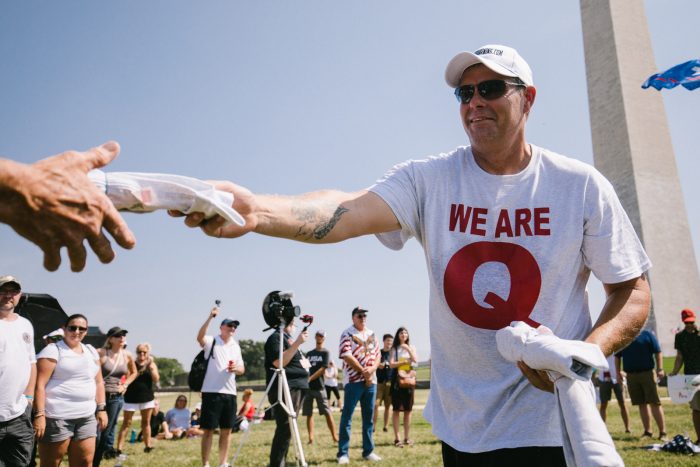
Today, people arrive at the QAnon phenomenon from any one of a variety of on-ramps, whether through misplaced concern for the safety of children, interest in the sudden prison death of ultra-wealthy pedophile Jeffrey Epstein, or even personally held religious convictions, for example. Although it is hard to gauge an estimate of how many people believe in different parts of the QAnon narrative, the movement has grown large enough to support a cottage industry of social media influencers, media personalities, authors, activists, and online retailers. NBC News reported in August that internal Facebook documents stated millions of users were members of QAnon groups on its platform; Facebook reportedly purged some 790 QAnon pages from its platform that month. In October, the company announced a complete ban of all QAnon-themed pages and groups from Facebook and Instagram. Although Twitter announced a ban of QAnon accounts in July, the Washington Post reports that the research group Advance Democracy found that some 93,000 QAnon-related accounts remain active on the platform.
Q Grows in the GOP Base
Another sign of QAnon’s growth is revealed in polling of the electorate. Awareness of the conspiracy theory and its networks has roughly doubled since March among U.S. adults, according to the Pew Research Center. A survey of U.S. adults published by Pew on Sept. 16 found that while 41 percent of Republicans told interviewers that the QAnon movement is good for the country, 90 percent of Democrats reported seeing it as being bad for the country.

More recently, a Yahoo News/YouGov poll of registered voters found that 50 percent of Trump supporters professed belief in QAnon claims.
When a small but loud contingent of QAnon believers gathered at a Trump rally in Tampa, Florida, in 2018, the conspiracy theory and its fans made their first national headlines. Wearing T-shirts and signs adorned with QAnon slogans and symbols, they positioned themselves in the sightlines of news cameras and made themselves impossible to ignore. The prominent appearance of QAnon fans at Trump rallies has become an ever-present feature of those audiences.
Throughout its existence, QAnon has proven itself adept at weaving itself into narratives about the so-called “deep state,” special counsel Robert Mueller’s investigation into Russian meddling in the 2016 election, and other prominent conversations as they churn through right-wing media. Q offered Trump supporters a reason to stay calm. The anonymous writer(s) told followers that the Mueller investigation was actually a front for a secret investigation against the cabal, that Trump was winning his war against the “deep state,” and that soon—any day, now—the “truth” would be revealed and America would change forever.
Although QAnon began on the outskirts of the popular internet, it quickly jumped to prominent social media sites and found a home with right-wing audiences online. Media personalities associated with the movement, such as DeAnna Lorraine of Infowars and Liz Crokin of YouTube fame, as well as the writer(s) behind the “Q” persona, encourage fans to engage in social media campaigns, seeking to make topics trend on Twitter and to send specific pieces of content viral in hopes of spreading the message of Q. These campaigns have often been thought out and coordinated, and some have met tremendous success.
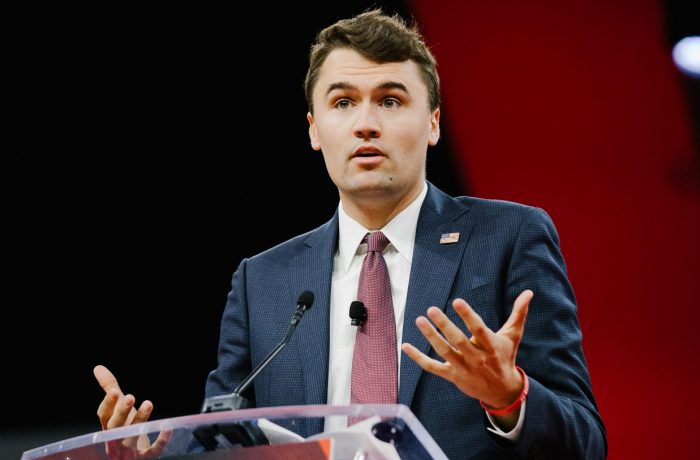
Travis View, a QAnon researcher and co-host of the “QAnon Anonymous” podcast, noticed in July 2018 that a claim made by a QAnon conspiracy theorist had found its way to the Twitter feed of Turning Point USA Founder and President Charlie Kirk, an influential figure in the modern GOP who is close to Trump. At the time, View noted in a Washington Post column that anonymous users working together on image boards like 8chan “represent a political force that can craft resonant narratives and push them through major social media networks into the mainstream.”
(In an interesting turn of events, Facebook banned a Turning Point USA contractor, Rally Forge, on Oct. 8 for allegedly crafting hundreds of fake social media accounts for a troll farm in the service of TPUSA.)
“The fast spread of QAnon, despite the insanity of the conspiracy theory’s premise, shows that these shadowy parts of the Internet already have influence,” View wrote in 2018. “Many anons (anonymous people who post to message boards) would no doubt find the description of them as ‘influential’ flattering. Influence is their goal, after all. People on 8chan’s /qresearch/ board believe the country’s agenda is being illegitimately set by a compromised mainstream media or an evil cabal, so these Q believers use the power of social media to wrestle some influence away from the institutions they sometimes call the ‘mockingbird media.’”
QAnon has received tacit and sometimes explicit support from some in the highest ranks of the Republican Party. Despite Trump’s self-professed ignorance, his Twitter account has shared, on a semi-regular basis, posts made by pro-QAnon accounts. Before a Trump rally in Tulsa, Oklahoma, on June 20, the president’s son, Eric Trump, posted a QAnon image to his Instagram page. And Eric’s wife Lara Trump once shared a video from a prominent pro-QAnon social media account.
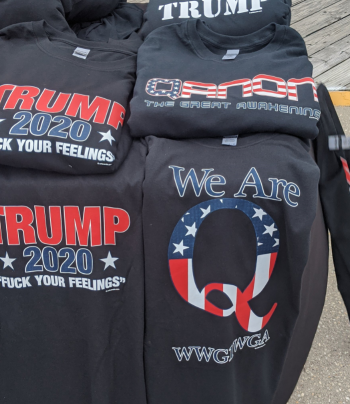
Trump campaign operatives who went on to become felons have found sympathy among the Q crowd and returned the favor. Former national security adviser Michael Flynn has leaned in deep to his support among followers of Q, and longtime Trump friend and former campaign adviser Roger Stone has courted sympathy among QAnon adherents. QAnon personalities have been invited to the White House on several occasions. In 2019, QAnon enthusiasts rallied within eyesight of the White House, marking one of the first major offline gatherings of the Q-niverse.
Organizers of that rally had planned to hold a similar event outside the Republican National Convention this year until the convention was relocated from Jacksonville, Florida, to locations in Charlotte, North Carolina, and Washington, D.C. The Trump campaign dropped a speaker, Mary Ann Mendoza, from the Republican National Convention lineup after she shared an anti-Semitic QAnon conspiracy theory on Twitter.
Vice President Mike Pence was scheduled to appear at an event hosted by Q believers Caryn and Michael Borland who, according to the Associated Press, “have shared QAnon memes and retweeted posts from QAnon accounts,” but canceled his planned appearance at the event after AP reported on the hosts’ QAnon links.
During an Oct. 15 town hall event in Miami, Trump was asked again whether he would disavow QAnon. Rather than do so, he offered words of praise for the movement, saying, “What I do hear about [QAnon] is that they’re very strong against pedophilia, and I agree with that.”
Candidates Believing in and Pandering to QAnon
Dozens of 2020 congressional candidates—most of them running as Republicans—have dabbled in some form of the conspiracy theory and a couple of QAnon-friendly candidates are on track to become new members of the U.S. Congress in 2021. Although some Republicans have recently denounced the conspiracy theory, their words add up to too little, too late.
QAnon promoter Marjorie Taylor Greene won her Republican primary runoff in Georgia’s 14th Congressional District in August, making her a shoo-in for a seat in the House of Representatives; if seated as expected, she’ll be the first explicit believer of the conspiracy theory to have obtained such high office. (Kevin Van Ausdal, Greene’s general election Democrat opponent, dropped out of the race in September after he was served divorce papers from his wife and moved in with family members who live out-of-state. Ausdal says the stress of enduring smears and threats from members of the QAnon community cost him his marriage.) Trump congratulated Greene after her primary win. The research organization Media Matters for America notes that Greene has spoken favorably of QAnon on several occasions, calling Q a “patriot” who is “worth listening to.” In an August Fox News interview, however, Greene tried to step around her QAnon allegiance without expressly disavowing it.
Lauren Boebert secured the Republican nomination for Colorado’s 3rd Congressional District in June and will appear on the ballot this November. In May, she told Ann Vandersteel, a conspiracy-theorist YouTuber, that she is “very familiar” with the QAnon movement, and that she believed the conspiracy theory was “only motivating and encouraging and bringing people together, stronger—and if this is real, then it can be really great for our country.” Boebert is reported to be in a tight race against the Democrat Diane Mitsch Bush.
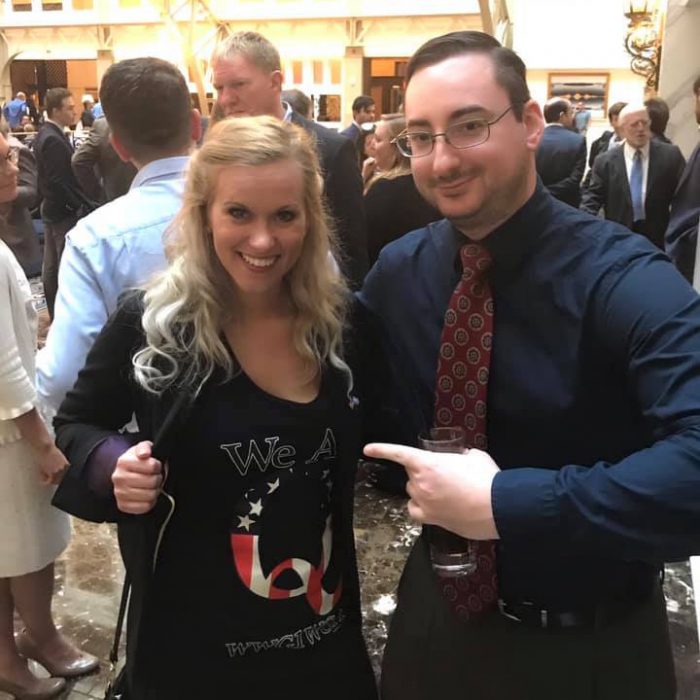
Lauren Witzke won the Republican primary election for Delaware’s U.S. Senate seat, defeating—by a double-digit margin—a primary opponent backed by the state’s Republican Party, despite having tweeted QAnon slogans and been photographed wearing a QAnon T-shirt. Witzke is also friendly with extreme right-wing figures, including Nick Fuentes, a white nationalist podcaster, and Peter Brimelow, the editor of VDARE, a white nationalist publication. Although she stands little chance of winning her election against Democratic Sen. Chris Coons, she’s now a legitimate Republican Party nominee for high office.
Another QAnon-booster who gained the Republican nomination for a U.S. Senate seat is Jo Rae Perkins, who is challenging incumbent Democratic Sen. Jeff Merkley of Oregon. In January, Perkins told Right Wing Watch that vocalizing her support of QAnon was “a very, highly calculated risk” and “either pure genius or pure insanity.” Count Trump-booster and former Arkansas governor Mike Huckabee as leaning toward the “genius” lane; his HuckPAC endorsed Perkins, contributing $5,000 to her campaign.
Since they gained political visibility, Greene, Witzke, and Boebert have all attempted to distance themselves, just a bit, from their prior expressed support of QAnon. Greene and Boebert were both invited to the White House to watch Trump’s RNC nomination acceptance speech.
The sheer number and occasional successes of Q-supporting candidates indicates that there exists support for QAnon in the GOP base to the degree that candidates are factoring in the movement as a constituency that can be courted to their electoral advantage. In 2019, a Trump campaign official appeared on a QAnon show to recruit campaign volunteers.
Media Matters has compiled a running tally of dozens of candidates who have expressed support for QAnon.
Just through the act of running for office, Melissa Ryan says, “these folks are building political power.”
QAnon Has Left Its Bubble
In 2020, and especially since the onset of the COVID-19 pandemic, the QAnon conspiracy theory has evolved and spread beyond the confines of right-wing internet communities and into spaces traditionally thought to be outside the realm of such organizing, especially through the online campaign #SaveTheChildren.
MMA fighters, mommy bloggers, health and wellness influencers, and others have adopted conspiracy theories popularized by QAnon believers in 2020, spreading them beyond the message boards and pro-Trump groups regarded as QAnon’s primary stomping grounds. The coronavirus pandemic has acted as an accelerant to the QAnon movement, whose proponents have leveraged skepticism and conspiracy theories about mask-wearing to boost the QAnon profile. Hundreds of rallies for the “Save the Children” campaign have been organized across the U.S., and QAnon has even leapt across borders; its supporters have appeared at rallies around the world.
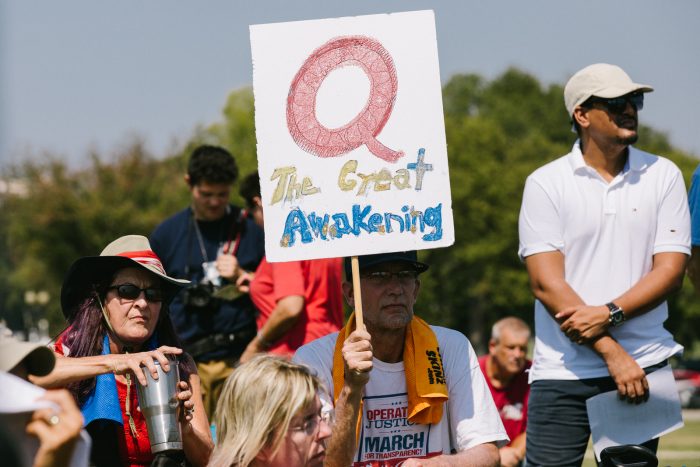
With its promise of a Great Awakening, QAnon has also made inroads with prominent religious-right figures, such as pastor Johnny Enlow, a leading evangelist of Seven Mountains Dominionist theology. Enlow has linked Seven Mountains beliefs to the conspiracy theory, telling his disciples that QAnon “connects to our overall message.” Kevin Jessip, who helped organize “The Return” prayer rally on the National Mall in September, has promoted QAnon theories mixed with Christian prophecy. The Q-promoting, Christian streaming service Brio TV enjoyed a large presence at the National Religious Broadcasters 2020 Christian Media Convention, and Charisma Media, a major Pentecostal media outlet, published an article stating that it was “unclear whether QAnon is a hoax or a real movement” but that it “should move all believers to study, prayerfully discern and above all else, urge other[s] to pray and mobilize the 37 million believers who did not vote in 2016.” Operation Rescue, a radical anti-choice protest group, pointed its supporters toward Q posts in early 2018.
The diversification of QAnon has been a major factor in its ability to remain resilient, despite social media companies’ recent measures to mitigate the spread of the conspiracy theory on their platforms.
Why It Matters
QAnon is not just a font of disinformation, it’s also dangerous to public safety and democracy.
A small minority of Q fans have been seemingly compelled to criminal action by the conspiracy theory. The FBI has described the conspiracy theory as a potential source of domestic terrorism, and to date, QAnon followers have charged with crimes including kidnapping, aggravated assault, terrorism, and murder. Many experts fear that the frequency of such acts will increase alongside the growth of QAnon.
A report from the Combating Terrorism Center at West Point stated that QAnon’s growth, in tandem with the 2020 presidential election, “seems likely to only increase QAnon’s salience, an increasing frequency of criminal or violent acts by QAnon supporters seems possible, even likely.”
But QAnon poses broader risks to the public. QAnon has supercharged conspiracy theories about the pandemic, encouraging and courting public doubt of public health measures meant to lessen the spread of the disease, which has killed more than 200,000 Americans. QAnon followers have also hyped alternative health cures for the disease like hydroxychloroquine, which the FDA warns can cause heart problems and offers no discernable benefits as treatment for the coronavirus.
And above all, QAnon seeks to discredit the institutions that the republic was built upon while presenting Trump as the lone savior figure who can rescue it.
Conclusion
The fallout from QAnon is likely to be felt during the 2020 election and long afterward. A series of bogus claims dumped into an internet cesspool has started a movement that will soon have representation in the U.S. Congress.
Whether Trump wins or loses, our political system now must to contend with the fact that a considerable number of people in the country who believe that a Satanic cabal of pedophiles is running the government and a GOP that chooses more often than not to look the other way as this corrosive movement takes root in its base.
As QAnon crawls further out from the digital fever swamps in which it once resided, it also presents new challenges for the non-political spaces where the presence of the conspiracy-theory movement can be felt.





